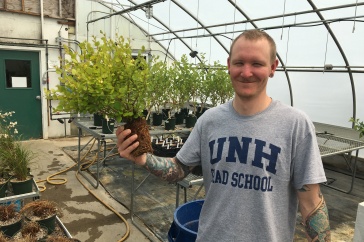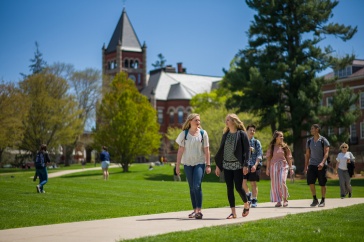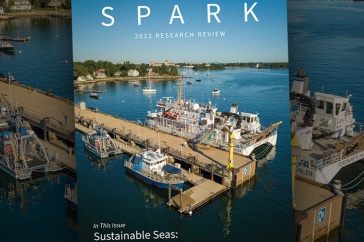Winter is here in the Northern Hemisphere, and the skiers among us eagerly await that first bluebird day, when the sun rises over freshly fallen snow and blue skies beckon. Emily Larson is surely one of them. But, then, there have been a lot of bluebird days for Larson lately, even though it hasn’t snowed yet.
Emily Larson ’16 is a Boulder, Colo., native who came to UNH in the fall of 2012 to study exercise science and take her place on the Nordic ski team. If the demands of a college athlete’s schedule have her frenzied, you can’t tell; she has the friendly, laid-back mannerisms typical of so many Coloradoans.
So when talking to Larson about two awards she received recently at the New England American College of Sports Medicine’s (NEACSM) annual meeting in Providence, Rhode Island, you might not get the impression they are a big deal. But they are.
Timothy Quinn, professor of kinesiology, puts it into perspective: “To win one of these awards is really impressive, but to be awarded both is unprecedented.”

Larson received both the Robert S. Axtell Undergraduate Scholarship and the NEACSM Student Investigator Undergraduate Award. The Axtell award recognizes the most outstanding undergraduate exercise science student in all of New England. The student investigator award recognizes the research she conducted under Quinn’s guidance during the past year and her presentation of that research at the NEACSM meeting.
Larson is the first student in the UNH College of Health and Human Services to receive both awards in the same year.
Her research examined the cardiac characteristics of collegiate Nordic skiers in order to identify any abnormalities in the electrical conduction system of the heart.
“Cross-country skiers, later in life, have an increased prevalence of atrial fibrillation,” Larson explains. “I wanted to see, at the collegiate level, if there were any precursors to that.”
It’s the first time such research has targeted this age group. The idea for the project came to Larson during an electrocardiogram class during the 2014 fall semester when Quinn was talking about the electrical differences between endurance athletes and others. Larson had been looking for a research topic, and the prospect of delving deeper into one near and dear to her heart — she’s been cross-country skiing since she was 12 — appealed to her. “It was lucky, for sure, for me to find it,” Larson says. “I feel like it was perfect.”
That fall, she conducted an exhaustive survey of all the research on the subject, sought and received a research grant from the College of Health and Human Services and gained approval from the UNH board that oversees research on human subjects. Then, as soon as the ski season ended this past spring, she summoned her teammates to the Robert Kertzer Exercise Physiology Laboratory, collected their height, weight and blood pressure and hooked them up with wires to conduct 12 lead electrocardiograms. During the summer, she did the same with a control group of inactive college students.
Then she crunched the data and hurried to submit it to NEACSM for consideration for its annual meeting — a fruitful endeavor.
“What we found was pretty much what you would expect to happen with endurance athletes — bigger, stronger hearts, slower heart rates — everything that you want to have happen. Our question was, if we were to follow these same skiers and they were to continue training throughout their whole lifetime, how would those indicators change for the better or worse?” Larson says.
Quinn describes Larson as a “thoughtful, intelligent and inquisitive” researcher who is “quietly confident.”
Larson attributes much of her success to her faculty mentor.
What’s a Workout Look Like?
Larson and her teammates work out six days per week as a team. You’ve probably seen them roller skiing around Durham and may have caught a glimpse of them on Long Sands Beach in nearby York, Maine (see “Powder Days?”), or in the weight room at the field house. Among Larson’s favorite workouts: running through College Woods and on the trails at Kingman Farm.
“None of it would have happened without Dr. Quinn,” she says. “He really helped introduce me to cardiovascular research, and he was a huge part of the reason that my project was successful,” she says. “I am really thankful to him for all the help and advice he gave me throughout the process.”
She hopes to continue with cardiovascular research, and graduate school is a possibility.
That would be a boon to the field, according to Quinn, who says Larson brings unique assets to her scholarship.
“I’ve seen her train in the heat of summer, autumn rain and driving snow of winter,” Quinn says. “She is so dedicated to her sport and to being the very best Nordic skier she can be. That requires discipline, the ability to manage time efficiently, the ability to handle stress … Emily brings all of those athletic skills and coping mechanisms to the research laboratory.”
It’s been a bluebird semester for Emily Larson, and now she’s taking a brief break. She’s headed home to Boulder, where copious snowfall has blanketed the city and nearby slopes, and the extended forecast calls for nothing other than sunshine and blue skies.
Larson will return to New Hampshire in early January to join her teammates in the White Mountains for ski camp.
Powder Days?
Why would a high-school senior and Nordic skier from powder country choose to attend college in the icy east?
For Emily Larson ’16, the presidential and athletic scholarships UNH offered helped persuade her, as did the spot on the Nordic ski team.
“It’s a lot icier here,” she confirms. “But it’s still nice, and New England has its cozy winter charm. It’s definitely an adjustment but not a bad one.”
An adjustment in more ways than one: Larson says when skiing at a lower altitude (the Durham campus is just 43 feet above sea level) “your legs start to hurt before your lungs. Back home, your lungs are done before your legs. It’s something you have to get used to.”
By sheer luck for Larson, the last two winters have seen New England’s snowfall totals surpass those of the Centennial State.
Plus, here she gets to train in a way she would never be able to in the landlocked west — on beach sand at the Atlantic shore, a workout that she says “definitely turns heads.” Video
Larson has also enjoyed traveling around to the different race venues. “I feel like I get to see the east, whereas I wouldn’t normally be able to experience that.”
Her favorite days are when it snows on campus and she and her teammates can ski in the loop. “You can just wake up and put on your skis right there — it’s really convenient and fun.”
Larson skis alpine, too, and will try to fit a lot of that in during winter break. Back home, she likes Steamboat a lot, but, she says, “If the snow’s right, if the day’s right, I’d be pretty happy to be just about anywhere.”
-
Written By:
Tracey Bentley | Communications and Public Affairs


















































